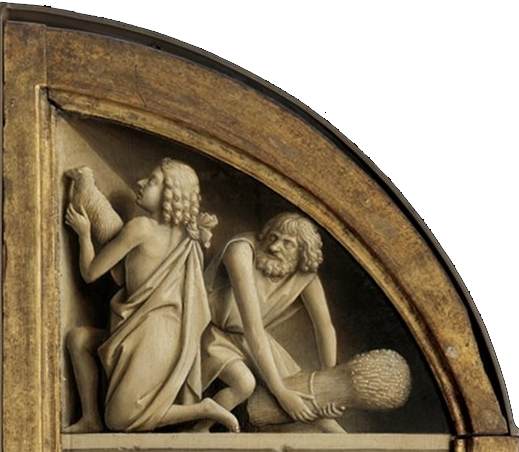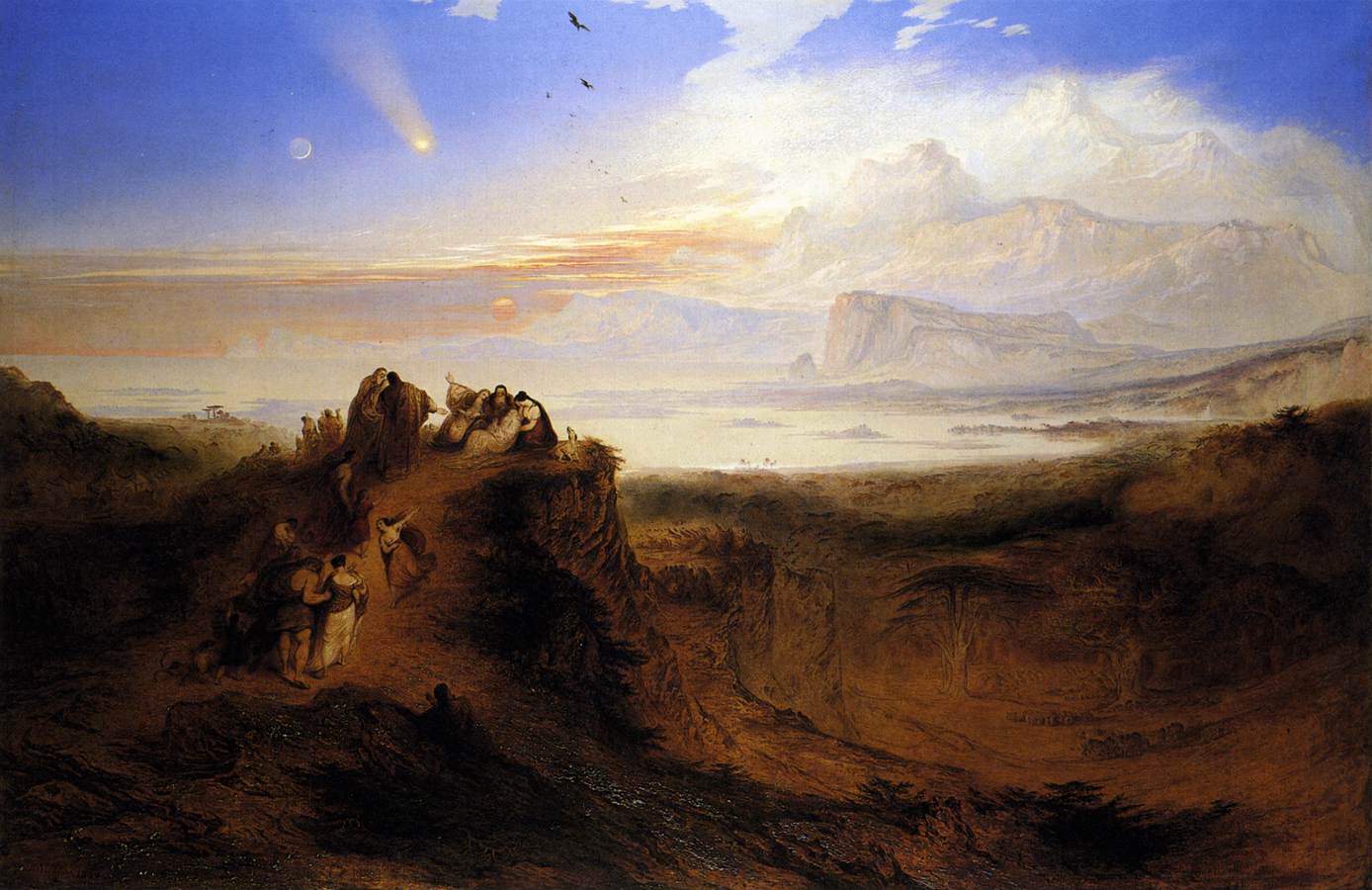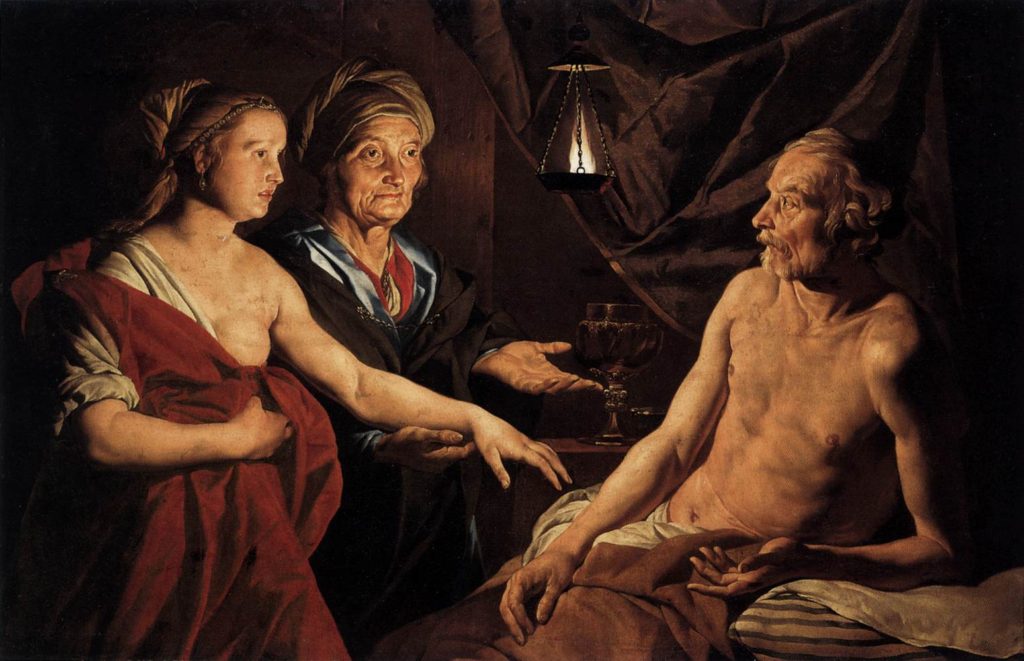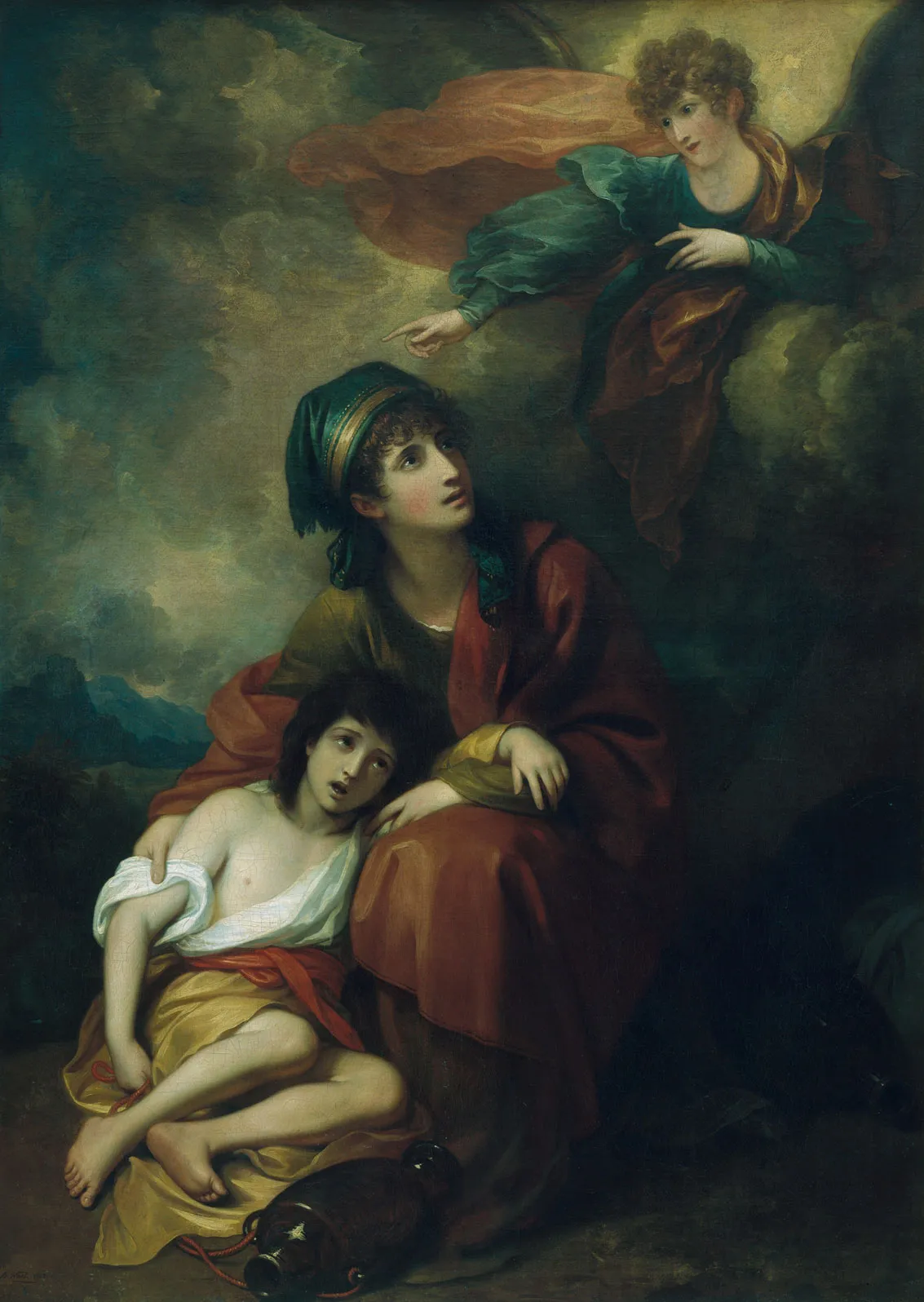The seven-day sequential creation narrative.
The פ markers are for each day, but the separate days are left together as one section because of the unity of the 7-day week.
This account of creation focuses on the relationship of God with man.
The serpent deceives Eve, and then Adam goes along with the deception.
The results of the broken relationship and its mending.
The origins of mankind’s fallen state
Adam and Eve (Chavah) are expelled from the garden of Eden.
The Tree of Life is put under the guardianship of powerful Cherubs
to prevent evil from becoming immortal.
Adam and Eve beget Cain and Abel.
Cain murders Abel through envy that God favors Abel’s offering:

The Offering of Abel and Cain 1425-29 by Jan van Eyck
Cathedral of St Bavo, Ghent
Courtesy of the Web Gallery of Art
The genealogy of Cain indicates there were good and talented people
amongst his descendants, showing that God is not a respecter of persons.
Adam and Eve (Chavah) beget Seth and a fresh genealogical line (that eventually leads to Abraham) is restarted 130 years after Creation.
The last verse in this section (4:26) indicates that profanation had also spread within the chosen line by the time of the birth of Enosh, just 230 years after Creation (see 5:5).
The genealogy of the holy race from the creation of Adam and Eve,
through to Jared (Jered) begetting Enoch (Chanoch).
The account of Enoch and his walking with God,
then God takes him without seeing death.
Enoch’s forbears and descendants all taste death.
The end of a pre-flood era with the life of the oldest recorded person, Enoch’s son, Methuselah.
The next section records a major turn in history when Noah is born.
The birth of Noah is the harbinger of the new age to come.
The Nephilim appear on Earth and work to corrupt the whole society through match-making the inter-marriage between believers in the True God and followers of men, thus creating beings whose spirit is according to themselves.
The earth is filled with violence and wrongdoing and
the continuous evil thinking of man, are
given as the main reasons for the flood.
Noah is selected to be the progenitor of the human race due to his covenant relationship with God and his obedience to His instructions.
God confirms His Covenant with Noah and he is instructed to enter the ark.
This is the longest section of Genesis so far, where the Masoretes have only one (פ) at the end of chapter 9 verse 17. It indicates the long ordeal of the Deluge that lasted over 1 year.
Suggested Timeline
Adding 7 days from when Noah entered the Ark before the beginning of the Deluge until the time that he left, there are between 377 and 378 days, if a 30-day month is understood.
If this is the case, then there must have been a change in the Earth’s orbit around the sun during the Deluge due to this major upheaval.
In post-deluge calendars in Mesopotamia and Egypt and even today, it has taken over 4000 years to adjust.

The Eve of the Deluge 1840
Royal Collection, Windsor
Courtesy of the Web Gallery of Art
Noah plants a vineyard and becomes drunk.
Ham takes advantage of the situation, sees the nakedness of Noah, and commits incest with Noah’s wife.
Canaan, the son of this union, receives a curse that unfolds throughout the
history of mankind, as detailed throughout the Bible.
But the True God looks at the inward being, and Canaanite believers are grafted into the nation of Israel over the Millennia.
A history of how the greater world was populated by people groups and geographically through the descendants of Japheth and Ham.
Canaan’s progeny receives its own section of six verses to follow.
Significantly, the descendants of Canaan interacted with
Abraham, Isaac, and Israel in later centuries.
A key account, in relation to Israel:
Widow of Zarephath in the territory of Sidon/Zidon
The descendants of Shem,
and in particular Eber,
through whom the Hebrew nation came into existence.
The account of the building of a city and tower, Ka-dingir, ![]()
![]() which is Sumerian for “Gate of God”, “Doorway or Gate of Heaven” or “Star Gate”, inter alia.
which is Sumerian for “Gate of God”, “Doorway or Gate of Heaven” or “Star Gate”, inter alia.
JEHOVAH (THE LORD) changes the focus of humanity away from
building the Ka-dingir, by mixing the Sumerian language, resulting in the creation of various languages. This in turn causes the dispersion of the human race across the globe and the cessation of the construction of Ka-dingir, which is re-named Babylon.
In the Hebrew language, בָּבֶ֔ל (Babylon) carries the nuances of being
“mixed up and confused”. In Babylonian, an approximate equivalent, Bab-ilani, carries one of the meanings of Ka-dingir, as in “the gate of the gods”.
The meanings of Babylon vs Bab-ilani also serve as an illustration of the mixing of word meanings for the same or similar sounding words.
This section is split into multiple parts. Verses 10-25 give an unbroken account of descendants of Shem focusing on the Covenant line. Then in verse 27, the account moves to Terah and his immediate family, and the journey away from Ur of Chaldea.
Some observations are the reduction in lifespans. Shem lives a total of 602 years, and 502 after the flood. All his recorded descendants live just over 400 years until we get to Peleg, who lives just over 200 years. The ages then decline gradually until Nahor (148), who dies early per the general average.
Nahor’s son Terah lives 205 years, but Terah’s son Haran dies an early death,
as did his grandfather.
God calls Avram, a son of Terah, away from Charran to go to Cana’an.
Once in Cana’an, Avram builds a strong relationship with the LORD.
A severe famine occurs in Cana’an and Avram sojourns in Egypt.
Pharaoh takes Sarai as a wife, but the LORD intervenes.
Avram’s exit from Egypt. Lot separates from Avram.
The LORD takes Avram to the next stage of his spiritual journey.
The most powerful nations on earth subjugate surrounding nations.
The first-mentioned of the conquering kings, Amraphel, is commonly assumed to be Hammurabi of around 1750 BC. Interestingly, Hammurabi wrote a code of law with similarities to the laws written out by Moses. Many point to this as proof that the Mosaic laws were based on Hammurabi’s law code.
The above conclusion, however, does not include all the evidence.
Firstly, Hammurabi’s code has been found to be based on other codes written hundreds of years prior.
Secondly, all these older codes seem adulterated by the school of thought that higher status gives human beings higher value in the eyes of God; This does not underpin the Mosaic law. However, the non-Mosaic codes do prove the existence of common law for humanity, which has been expressed in various ways, with different slants.
Another interesting point is that Hammurabi existed around 1750 BC.
Upon closer examination of the Bible’s own chronology, 1750 BC does not coincide with the events of Genesis 14. So which chronology does one take as true, is more the question? Rabbinic tradition equates Amraphel with Nimrod, which could also be the case. In this site’s translation, we have deciphered Am-Raph-El as meaning “sink God’s people”, which echoes Nimrod’s “rebelling”.
A question arises when reading through the text:
1. Why is Amraphel mentioned first in the list of four foreign powers in verse 1, and then is only mentioned third in the list of verse 9?
2. Why is the revolt against control by CedorlaOmer mentioned as the reason for the campaign (verse 4).
An answer: Amraphel is the spiritual power and political head, and CedorlaOmer is the collector of tribute.
Avram conquers all, with divine help, and receives the blessing of God Most High.
Conquering the world’s greatest empires with an army of 318 combined with Avram’s three confederates would, under normal circumstances, be impossible. Suggested proofs that it really happened:
- What empire is going to record such a humiliating event?
(There doesn’t seem to be any extra-Biblical historical accounts). - Perhaps Hammurabi, who would have been well aware of the events of Genesis 14, decided to put some reforms into his own empire,
based on earlier law codes.
Avram receives confirmation of God’s Covenant regarding the Seed.
Avram follows Sarai’s suggestion to produce an heir by proxy.

Staatliche Museen, Berlin
Courtesy of the Web Gallery of Art
The Covenant of God in Circumcision and its importance.
The promises of God to Abraham, Sarah, Isaac, and Ishmael.
The LORD and two angels materialize themselves in human form
and engage in conversation with Avraham and Sarah.
The angels head out for Sodom.
The angels arrive at Sodom.
Lot attempts to persuade his relatives to flee.
Sodom and the adjacent area are obliterated.
The origins of Moab and Ammon.

Private collection
Courtesy of the Web Gallery of Art
Abraham, Abimelech, and Sarah.
Isaac is born.
Family conflict.
God Omniscient Omnibenevolent intervenes.

Abraham and Abimelech cut a covenant.
Abraham is asked by God to make the ultimate sacrifice.
